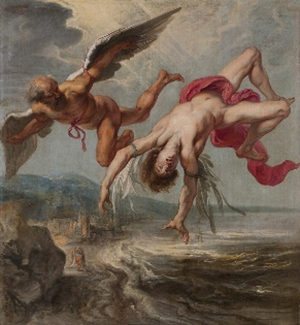Waxen Wings (Icarus)
Arriving sunwards with frail waxen wings,
How high could reach that forced unnatural flight?
— Book 10 Canto 2
In mythology, waxen wings are connected to the myth of Icarus.
This myth appears mainly in the Epitome of the Bibliotheca of Pseudo-Apollodorus i.11) and in the Metamorphoses of Ovid.
Icarus was the son of Daedalus, the architect who built the labyrinth to contain the Minotaur. Daedalus himself was later locked in the labyrinth along with his son.
To escape from there, he made wings out of feathers and wax for both of them.
But the infatuated Icarus, disregarding his father's injunctions, soared ever higher towards the sun, till, the glue melting, he fell into the sea and perished.
Jacob Peter Gowy The Fall of Icarus (1635–1637). Public domain
Daedalus belongs to the younger lineage of the kings of Athens and represents the ‘cleverness’ or ‘skill in works’ necessary for Yoga.
The myth of the Minotaur describes the spiritual downfall of the seeker after his first great experience following a partial enlightenment of his mind as narrated in the myth of Jason. The seeker uses this opening of consciousness for his own ego and locks himself into a mental construction that absorbs and justifies everything: it is symbolised by the labyrinth built by Daedalus that has the Minotaur at its centre. It was the hero Theseus who slew the Minotaur.
To continue on the path beyond the victory over the Minotaur, the seeker must abandon all pretence of reaching the supramental by his own strength.
That which in his being claims to rise to the supramental by means of artifice (wings as the symbol of the highly artificially developed mind) will be destroyed despite all warnings. Artifice cannot not withstand the fire of Truth (the flame of the sun god Helios).
